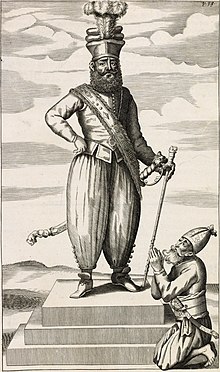Rajasinghe II
| Rajasinghe II | |
|---|---|
| King of Kandy | |

Rajasingha II, from Robert Knox's A Historical Relation of the Island Ceylon, 1693
|
|
| Reign | 1635 – 6 December 1687 |
| Coronation | 1635 |
| Predecessor | Senarat |
| Successor | Vimaladharmasurya II |
| Born | 1608 Sri Lanka |
| Died | 6 December 1687 Sri Lanka |
| Burial | Sri Lanka |
| Issue | Vimaladharmasurya II |
| House | House of Dinajara |
| Father | Senarat |
| Mother | Dona Catherina of Kandy |
Rajasimha II, also known as Rajasingha II (pre coronation, Prince Mahastana), was a Sinhalese King, reigned 1629 – 6 December 1687; third king of the kingdom of Kandy in Sri Lanka. Rajasingha requested Dutch aid to help expel the Portuguese from the island, which they successfully did in 1656. By this time however it had become clear to the Kandyans that the Dutch not only intended to expel the Portuguese but to replace them as the major colonial power on the island, and from 1645 onwards Rajasingha was engaged in sporadic warfare with his erstwhile allies.
Rajasingha was the son of Senarat (Senarath), the second ruler of the kingdom of Kandy, based at the city of Senkadagala (modern Kandy) in Sri Lanka's mountainous interior. Since the Portuguese annexation of much of Sri Lanka's coastal areas the kingdom had represented the sole independent native polity on the island. Near incessant warfare had significantly embittered the Kandyans towards the Portuguese; furthermore the brief success of the warlike kingdom of Sitawaka a century earlier had convinced many in the kingdom that the total expulsion of the colonial power was a distinct possibility.
As a young man Rajasingha participated in the 1612 counteroffensive that routed a Portuguese invasion into Kandyan territory.
Rajasingha succeeded his father to the throne in 1634 (1629 in some sources)
Rajasingha's father had long courted the Dutch as a potential ally against the Portuguese. A treaty had been signed between Kandy and Dutch envoy Marcelis Boschouwer but had not amounted to much. Soon after Rajasingha's accession however the Dutch, now firmly established in Batavia, put Portuguese Goa under a blockade. On 28 March 1638, Rajasingha led his army to victory against the Portuguese forces at Gannoruwa. Soon after this, Rajasingha sent a request for aid to the admiral Adam Westerwolt and by 23 May 1638 had signed an extensive military and trade treaty with them. The Dutch seized Batticaloa on 18 May 1639 and a joint Kandyan–Dutch campaign began to make inroads into Portugal's lowland territories. The alliance was however deeply unpopular with the inhabitants of Kandy.
Tensions soon arose between the two parties. Batticaloa was the traditional port of the Kandyan kingdom (Trincomalee had long been lost, first to the Jaffna kingdom and then to the Portuguese), and Rajasingha was eager to acquire it as soon as possible. The Dutch, however, demurred, demanding full payment for their assistance in displacing the Portuguese. Despite a rising suspicion that the Dutch were not in Sri Lanka to expel the Portuguese, so much as to replace them, the alliance was one that was too valuable for Rajasingha to simply cancel, and joint Dutch–Kandyan efforts resulted in the seizure of Galle on 13 March 1640 and the restriction of Portuguese power to the west coast of Sri Lanka by 1641.
...
Wikipedia
